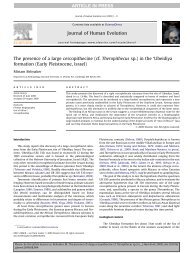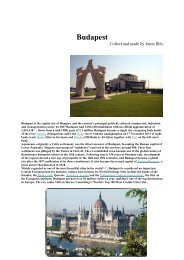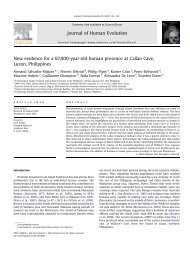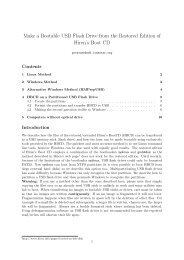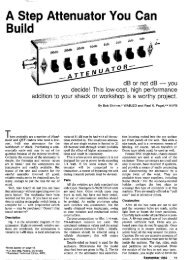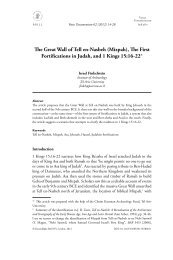Creativity, primordial cognition, and personality
Creativity, primordial cognition, and personality
Creativity, primordial cognition, and personality
Create successful ePaper yourself
Turn your PDF publications into a flip-book with our unique Google optimized e-Paper software.
1778 C. Martindale / Personality <strong>and</strong> Individual Differences 43 (2007) 1777–1785<br />
The purpose of the present article is to shed more light on the relationship rather than to deal with<br />
when it was first noticed.<br />
Although creativity involves a lot of very hard work, it is interesting that creative geniuses are<br />
virtually unanimous in their opinion that creative inspiration itself is effortless <strong>and</strong> not under conscious<br />
control (Ghiselin, 1985). It tends to occur in states of reverie in which <strong>cognition</strong> is disinhibited<br />
in the sense of not being hierarchically organized or guided by purpose or design.<br />
When analyzed, creative ideas are found to be novel combinations of old ideas previously<br />
thought to be unrelated. Martindale (1981, 1995, 1999) showed, when expressed in terms of a<br />
neural-network framework, that all plausible theories of creativity are almost identical but merely<br />
expressed in quite different vocabularies. It is generally agreed that consciousness or states of mind<br />
vary along a continuum ranging from ordinary, wakeful, reality-oriented, rational, problem-solving,<br />
conceptual <strong>cognition</strong>, through several types of fantasy <strong>and</strong> reverie to dreaming. The further<br />
one gets from waking problem solving <strong>cognition</strong>, the more thinking becomes irrational, free associative,<br />
unconcerned with purpose or problem solving, <strong>and</strong> dominated by concrete images rather<br />
than abstract concepts. Attention is narrowly focused in conceptual states. It becomes increasingly<br />
defocused as we move toward <strong>primordial</strong> <strong>cognition</strong>. Theorists as diverse as Berlyne<br />
(1965), Freud (1900), Nietzsche (1872), Werner (1948), <strong>and</strong> Wundt (1896) have given this continuum<br />
various names. For want of a better term, I refer to it as the conceptual-<strong>primordial</strong> <strong>cognition</strong><br />
continuum. (In some earlier publications, I used the terms secondary process-primary process, but<br />
this caused confusion, as readers thought that I was embracing Freudian theory rather than just<br />
using the terms in a descriptive manner.)<br />
In order to increase the probability of having a creative idea, one must regress from conceptual<br />
toward <strong>primordial</strong> <strong>cognition</strong>. This works only up to a point, however. The probability of having a<br />
creative idea is related in an inverted-U fashion to the degree that <strong>cognition</strong> is <strong>primordial</strong> in nature.<br />
Extremely <strong>primordial</strong> <strong>cognition</strong> is too diffuse <strong>and</strong> holophrastic to yield creative ideas. Thus,<br />
creative ideas usually arise from states of reverie <strong>and</strong> virtually never from dreams (Martindale,<br />
1995).<br />
In extremely conceptual <strong>cognition</strong>, ideas may be compared to atoms in a crystal. The atoms<br />
(ideas) are precisely fixed in place in extremely conceptual <strong>cognition</strong>, so that a new combination<br />
is completely impossible. If we heat the crystal, it will turn into a liquid, <strong>and</strong> the bonds amongst<br />
atoms will loosen. The probability that two remote atoms will combine with each other is<br />
increased. This is analogous to a movement toward more <strong>primordial</strong> <strong>cognition</strong>. This movement<br />
increases the probability that remotely associated ideas will be combined. If we apply even more<br />
heat, our liquid will eventually become a gas. Now virtually any atom (word, image, or idea) may<br />
combine with any other. This corresponds to a state of extreme <strong>primordial</strong> <strong>cognition</strong>. On the mental<br />
level, it leads not to novelty but to nonsense, as the ideas combined will be r<strong>and</strong>omly related. In<br />
neural-network terms, conceptual <strong>cognition</strong> <strong>and</strong> focused attention correspond to a situation in<br />
which a very small number of nodes representing ideas, words, or images are very highly activated.<br />
On the other h<strong>and</strong>, <strong>primordial</strong> <strong>cognition</strong> <strong>and</strong> defocused attention may be modeled as a<br />
state in which a large number of nodes are activated but to a slight degree. This of course increases<br />
the probability of noticing a novel combination if the nodes are activated sufficiently to enter<br />
consciousness.<br />
Once one has had a creative idea, one must do something with it. It is necessary to move to a<br />
state of conceptual <strong>cognition</strong> in order to verify or elaborate the new idea. If one is a scientist,




